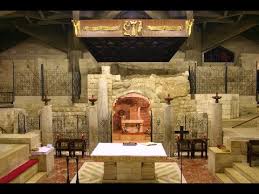I want to put before you some thoughts on the meaning of the crucifix (Lat., “A crucified is my beloved”). I have in mind the standard crucifix found in a parish church, with a white unblemished corpus, depicting Our Lord still alive, and “INRI” written above. Like all Christians, I love a plain cross of wood, which invites us to embrace it. But the crucifix seems an even superior object of devotion. Can we say why?
There are two traditional reasons. First, the crucifix – more than a plain cross -resembles the serpent on a stake: “as Moses lifted up the serpent in the desert, so must the Son of man be lifted up, that whosoever believeth in him, may not perish; but may have life everlasting.” (Jn 3:14) Why then diminish this healing sign? Or how do we “believeth in him,” if we remove him? The mere cross in comparison is as if a bare stake, that which lifts up but not the One lifted up.
Second, the crucifix seems to express better the basic Christian message, as explained by St. Paul: “And I, brethren, when I came to you … judged not myself to know anything among you, but Jesus Christ, and him crucified.” (1 Cor 2:1-2) St. Paul says, not that he restricts his preaching to “the cross,” but rather to “Christ crucified.”
These reasons are strong and presumably alone explain why, as exorcists say, devils flee especially from the crucifix. But can we add other reasons?
Here is the sort of thing I mean: All of the apostles, with a notable exception, fled when Our Lord was crucified. Therefore, these official “witnesses of the Lord from the beginning,” strangely, failed to witness His main saving act, the very reason why He came into the world. The crucifix, then, captures for us what they missed.
But more than that: we know that St. John and Mary the Mother of Our Lord did keep watch at the foot of the cross. The crucifix is distinctively the view of St. John and Mary. So, when you and I contemplate the crucifix today, we take our place alongside them; we see what they alone saw; we enter into solidarity with them and become identified with them.
Another reason is found in the words on the crucifix, “Jesus of Nazareth, king of the Jews.” (INRI) Behold the crafty providence of God, which caused the chief Roman official of that time and place, as if against his intention, to give testimony to the truth about the Lord. Aren’t you heartened to think: if God could cause even the Roman Empire thus to bend its knee, what can’t He do in any age?
Or what about what the standard crucifix omits: it does not show any signs of a scourging? Saints have told us, as the Shroud of Turin corroborates, that the brutal Roman scourging tore every inch of His flesh, so that his body became a bloody, pulpy mess.

Pious instinct, apparently, while knowing these truths, has judged that they are literally “obscene” —that is, better left off stage. And this I love: the standard crucifix in this manner conveys Our Lord’s modesty and delicacy. He does not wish even to give the appearance of reproaching us.
Precisely through what is absent, we have scope to make up the difference: we can, if we wish, supply the awful wounds in our imagination. These wounds, caused by our sins, represent them; thus, by adding them freely ourselves, it’s as if we confess them.
Here are some other remarkable traits about the crucifix.
First, on the crucifix, the body of the Lord is lifted off the ground and placed in “the air.” We – with our scaffolding, elevators, and skyscrapers – don’t even notice that this is unusual. Yet the Fathers of the Church were so taken with this aspect – that a crucifixion implied a suspension in air – that they held that the element of “air” (traditionally also a dwelling place of daemons) was thereby purified and sanctified, just as Our Lord’s baptism affected all waters.
Second, on the crucifix, Our Lord assumes a posture not seen in ordinary life, namely, standing upright, legs together, with arms outstretched. The posture is so unusual that Leonardo’s drawing of it, “Vitruvian Man,” has become iconic. Leonardo was not drawing Christ on the cross but intending to illustrate the proportions of the human body: a man standing upright with outstretched arms is inscribed perfectly by a square (that is, a man’s “wingspan” is generally equal to his height).
For Leonardo, the proportions internal to the human body, a “microcosm,” testified to man’s ordered place within a universe of law and proportion, the “macrocosm.” But the crucifix, through the same bodily form, teaches this very truth at its deepest, spiritual level: “He humbled himself, becoming obedient unto death, even to the death of the cross.” (Phil. 2:8) More than this: because the hands of the Vitruvian man face downward, while Our Lord’s face outward, this display of humility on the cross is clearly, at the same time, a priestly embrace.
Third, the standard crucifix depicts Our Lord as still alive, even though salvation is fully accomplished only at his death (“It is finished”, Jn 19:30). But this too is remarkable: everyone who has ever kept vigil at a deathbed knows how precious those last hours are; but it seems improper to try to capture them, and we don’t do so – perhaps because we recognize intuitively that death for us is a penalty for sin. For Our Lord it is different: since his death was unwarranted but freely accepted, we can depict his “death bed” always, and are invited to keep vigil always.
The crucifix and the cross: the former is found almost solely in churches in which Our Lord is Really Present, which suggests a last recommendation – the crucifix with its substantial corpus is simply a better sign that, indeed, “This is my body” and “This is my blood.”
*Image: Crucifix by an unknown artist, c. 1700 (Victoria & Albert Museum, London]
You may also enjoy:
Elizabeth A. Mitchell’s The Paradox of Pain
Stephen P. White’s Hope and Dying














